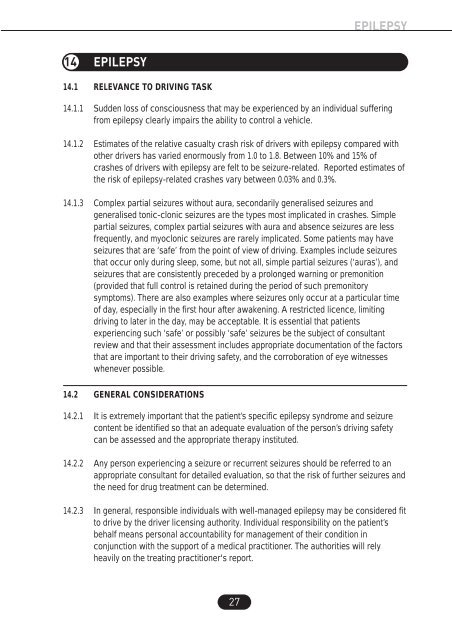Assessing Fitness to Drive - BiOptic Driving Network
Assessing Fitness to Drive - BiOptic Driving Network
Assessing Fitness to Drive - BiOptic Driving Network
- No tags were found...
Create successful ePaper yourself
Turn your PDF publications into a flip-book with our unique Google optimized e-Paper software.
EPILEPSY14 EPILEPSY14.1 RELEVANCE TO DRIVING TASK14.1.1 Sudden loss of consciousness that may be experienced by an individual sufferingfrom epilepsy clearly impairs the ability <strong>to</strong> control a vehicle.14.1.2 Estimates of the relative casualty crash risk of drivers with epilepsy compared withother drivers has varied enormously from 1.0 <strong>to</strong> 1.8. Between 10% and 15% ofcrashes of drivers with epilepsy are felt <strong>to</strong> be seizure-related. Reported estimates ofthe risk of epilepsy-related crashes vary between 0.03% and 0.3%.14.1.3 Complex partial seizures without aura, secondarily generalised seizures andgeneralised <strong>to</strong>nic-clonic seizures are the types most implicated in crashes. Simplepartial seizures, complex partial seizures with aura and absence seizures are lessfrequently, and myoclonic seizures are rarely implicated. Some patients may haveseizures that are ‘safe’ from the point of view of driving. Examples include seizuresthat occur only during sleep, some, but not all, simple partial seizures (‘auras’), andseizures that are consistently preceded by a prolonged warning or premonition(provided that full control is retained during the period of such premoni<strong>to</strong>rysymp<strong>to</strong>ms). There are also examples where seizures only occur at a particular timeof day, especially in the first hour after awakening. A restricted licence, limitingdriving <strong>to</strong> later in the day, may be acceptable. It is essential that patientsexperiencing such ‘safe’ or possibly ‘safe’ seizures be the subject of consultantreview and that their assessment includes appropriate documentation of the fac<strong>to</strong>rsthat are important <strong>to</strong> their driving safety, and the corroboration of eye witnesseswhenever possible.14.2 GENERAL CONSIDERATIONS14.2.1 It is extremely important that the patient’s specific epilepsy syndrome and seizurecontent be identified so that an adequate evaluation of the person’s driving safetycan be assessed and the appropriate therapy instituted.14.2.2 Any person experiencing a seizure or recurrent seizures should be referred <strong>to</strong> anappropriate consultant for detailed evaluation, so that the risk of further seizures andthe need for drug treatment can be determined.14.2.3 In general, responsible individuals with well-managed epilepsy may be considered fit<strong>to</strong> drive by the driver licensing authority. Individual responsibility on the patient’sbehalf means personal accountability for management of their condition inconjunction with the support of a medical practitioner. The authorities will relyheavily on the treating practitioner's report.27


